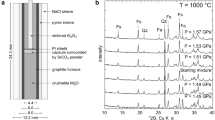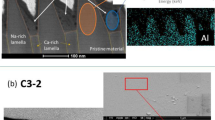Abstract
A mineralogic geobarometer based on the reaction garnet+clinopyroxene+quartz=2 orthopyroxene+anorthite is proposed. The geobarometric formulations for the Fe- and Mg- end member equilibria are
The end member thermodynamic data have been taken from the data base of Helgeson et al. (1978) and Saxena and Erikson (1983). The activities of pyroxene components and anorthite in plagioclase have been modelled after Wood and Banno (1973) and Newton (1983) respectively. The activities of pyrope and almandine are calculated from the binary interaction parameters for garnet solid solutions proposed by Saxena and Erikson (1983).
Pressures computed from these equations for fifty sets of published mineral data from several granulite areas are comparable with those obtained from dependable geobarometers. The pressure values determined from the Fe-end member equilibrium appear to be more reasonable than those from the Mg-end member reaction. It is likely that the difference in pressures computed from the Fe- and Mg-end members, ΔP *, have been caused by non-ideal mixing in the phases, especially in garnets.
Similar content being viewed by others
References
Berman RG, Brown TH (1985) Heat capacity of minerals in the system Na2O-K2O-CaO-MgO-FeO-Fe2O3-Al2O3 -SiO2-TiO2-H2O-CO2: representation, estimation and high temperature extrapolation. Contrib Mineral Petrol 89:168–183
Berman RG, Engi M, Greenwood HJ, Brown TH (1986) Derivation of internally-consistent thermodynamic data by the technique of mathematical programming: a review with applications to the system MgO-SiO2-H2O. J Petrol 27:1331–1364
Bhattacharya PK, Mukherjee S (1987) Granulites in and around Bengal anorthosite, Eastern India; genesis of coronal garnet, and evolution of the granulite-anorthosite complex. Geol Mag 123:21–32
Blencoe JG, Merkel GA, Seil MK (1982) Thermodynamics of crystal-fluid equilibria, with applications to the system NaAlSi3O8-CaAl2Si2O8-SiO2-NaCl-CaCl2-H2O. In: Saxena SK (ed) Advances in Physical Geochemistry. Springer, Berlin Heidelberg New York Tokyo, pp 191–222
Bohlen SR, Wall VJ, Boettcher AL (1983) Geobarometry in granulites. In: Saxena SK (ed) Advances in Physical Geochemistry. Springer, Berlin Heidelberg New York Tokyo, pp 141–171
Charlu TV, Newton RC, Kleppa OJ (1975) Enthalpies of formation at 970 K of compounds in the system MgO-Al2O3-SiO2 from high temperature solution calorimetry, with discussions of high pressure phase equilibria. Geochim Cosmochim Acta 42:367–375
Chatillon-Colinet C, Kleppa OJ, Newton RC, Perkins D (1983) Enthalpy of formation of Fe3Al2Si3O12 (almandine) by high temperature alkali-borate solution chemistry. Geochim Cosmochim Acta 47:439–444
Coolen JJMMM (1980) Chemical petrology of the Furua granulite complex, southern Tanzania. GUA Papers (Amsterdam) 13 (series 1) p 258
Ellis DJ (1980) Osumilite-sapphirine-quartz granulites from Enderby Land, Antarctica: P-T conditions of metamorphism, implications for garnet-cordierite equilibria and evolution of the deep crust. Contrib Mineral Petrol 74:201–210
Ellis DJ, Green DH (1979) An experimental study of the effect of Ca upon garnet-clinopyroxene exchange equilibria. Contrib Mineral Petrol 71:13–22
Essene EJ (1982) Geologic thermometry and barometry. In: Ferry JM (ed) Characterisation of metamorphism through mineral equilibria. Mineral Soc Am Rev Mineral 10:153–206
Fountain DM, Salisbury MH (1981) Exposed cross-sections through the continental crust: Implications for crustal structure, petrology, and evolution. Earth Planet Sci Lett 56:263–277
Ganguly J (1973) Activity-composition relations of Jadeite in omphacite pyroxene: Theoretical deductions. Earth Planet Sci Lett 19:145–153
Ganguly J, Saxena SK (1984) Mixing properties of aluminosilicate garnets: constraints from natural and experimental data, and applications to geothermobarometry. Am Mineral 69:88–97
Gasparik T (1983) Mixing properties of the diopside-jadeite solid solution. Abstr Geol Soc Am 13:456–457
Glassley WE, Sorensen K (1980) Constant P s-T amphibolite to granulite facies transition in Agto (Greenland) metadolerite: Implications and applications. J Petrol 21:69–105
Harley SL (1984a) The solubility of alumina in orthopyroxene coexisting with garnet in FeO-Al2O3-SiO2 and GaO-MgO-FeO-Al2O3-SiO2. J Petrol 25:665–696
Harley SL (1984b) An experimental study of the partitioning of Fe and Mg between garnet and orthopyroxene. Contrib Mineral Petrol 86:359–373
Harley SL, Green DH (1982) Garnet-orthopyroxene barometry for granulites and garnet peridotites. Nature 300:697–700
Harris NBW, Holt RW, Drury SA (1982) Geobarometry, geothermometry and late Archean geotherms from the granulite facies of South India. J Geol 90:509–527
Helgeson HC, Delany JM, Nesbit HW, Bird DK (1978) Summary and critique of the thermodynamic properties of rock forming minerals. Am J Sci 278 A:1–229
Hensen BJ (1976) The stability of pyrope-grossular garnet with excess silica. Contrib Mineral Petrol 55:279–292
Herzberg CT (1978) Pyroxene geothermometry and geobarometry: Experimental and thermodynamic evaluation of some subsolidus phase relations involving pyroxenes in the system CaO-MgO-Al2O3-SiO2. Geochim Cosmochim Acta 42:945–957
Holland TJB, Powell R (1985) An internally consistent thermodynamic data set with uncertainties and correlations: 2. Data and Results. J Met Geol 3:343–370
Janardhan AS, Newton RC, Hansen EC (1982) The transformation of amphibolite facies gneiss to charnockite in southern Karnataka and northern Tamil Nadu, India. Contrib Mineral Petrol 79:130–149
Johnson CS, Essene EJ (1982) The formation of garnet in olivinebearing metagabbros from Adirondack. Contrib Mineral Petrol 81:240–251
Johnson CA, Bohlen SR, Essene EJ (1983) An evaluation of garnetclinopyroxene geothermometry in granulites. Contrib Mineral Petrol 84:191–198
Kushiro I, Yoder HS (1966) Anorthite-forsterite and anorthite-enstatite and their bearing on the basalt-eclogite transformation. J Petrol 7:337–362
Newton RC, Haselton HT (1981) Thermodynamics of the plagioclase-Al2SiO5-garnet-quartz geobarometer. In: Newton RC, Navrotsky A, Wood BJ (eds) Thermodynamics of Minerals and melts. Springer, Berlin Heidelberg New York, pp 129–145
Newton RC, Perkins D (1982) Thermodynamic calibration of geobarometers based on the assemblages garnet-plagiocla-seorthopyroxene(clinopyroxene)-quartz. Am Mineral 67:203–222
Perkins D (1979) Application of new thermodynamic data to mineral equilibria. PhD Thesis. University of Michigan
Perkins D, Newton RC (1981) Charnockite geobarometers based on coexisting garnet-pyroxene-plagioclase-quartz. Nature 292:144–146
Perkins D, Chipera SJ (1985) Garnet-orthopyroxene-plagiocla-se-quartz barometry: Refinement and application to the English River Subprovince and the Minnesota River valley. Contrib Mineral Petrol 89:69–80
Powell R (1978) The thermodynamics of pyroxene geotherms. Phil Trans Roy Soc Lond, Ser A, 288:457–469
Räheim A, Green DH (1974) Experimental determination of the temperature and pressure dependence of the Fe-Mg partition coefficients of coexisting garnet and clinopyroxene. Contrib Mineral Petrol 48:179–203
Raith M, Raase P, Ackermand D, Lal RK (1983) Regional geothermobarometry in the granulite terrane of South India. Trans Roy Soc Edin 73:221–244
Robie RA, Hemingway BS, Fisher JR (1978) Thermodynamic properties of minerals and related substances at 298.15 K and 1 bar (105 Pascal) pressure and at high temperature. US Geol Surv Bull 1452, p 456
Robie RA, Finch CB, Hemingway BS (1982) Heat capacity and entropy of fayalite (Fe2SiO4) between 5.1 and 383 K: Comparison of calorimetric and equilibrium values for the QFM buffer reaction. Am Mineral 67:463–469
Sack RO (1980) Some constraints on the thermodynamic mixing properties of Fe-Mg orthopyroxenes and olivines. Contrib Mineral Petrol 71:257–270
Saxena SK (1973) Thermodynamics of rock forming crystalline solutions. Springer, Berlin Heidelberg, New York, p 188
Saxena SK (1979) Garnet-clinopyroxene geothermometer. Contrib Mineral Petrol 70:229–235
Saxena SK, Erikson G (1983) Theoretical computation of mineral assemblages in pyrolite and lherzolite. J Petrol 24:538–555
Sen SK, Bhattacharya A (1984) An orthopyroxene-garnet thermometer and its application to the Madras charnockites. Contrib Mineral Petrol 88:64–71
Sen SK, Bhattacharya A (1987) An assessment of orthopyroxenegarnet thermometry in granulite terranes. Ind J Geol 59:265–277
Srikantappa C, Raith M, Ackermand D (1985) High grade regional metamorphism of ultramafic and mafic rocks from the Archean Sargurterrane, Karnataka, South India. Precamb Res 30:189–219
Wells PRA (1979) Chemical and thermal evolution of Archean Sialic crust, Southern West Greenland. J Petrol 20:187–226
Wood BJ (1974) The solubility of alumina in orthopyroxene coexisting with garnet. Contrib Mineral Petrol 46:1–15
Wood BJ, Banno S (1973) Garnet-orthopyroxene and orthopyroxene-clinopyroxene relationship in simple ans complex systems. Contrib Mineral Petrol 42:109–124
Author information
Authors and Affiliations
Rights and permissions
About this article
Cite this article
Paria, P., Bhattacharya, A. & Sen, S.K. The reaction garnet+clinopyroxene+quartz =2 orthopyroxene+anorthite: A potential geobarometer for granulites. Contr. Mineral. and Petrol. 99, 126–133 (1988). https://doi.org/10.1007/BF00399372
Received:
Accepted:
Issue Date:
DOI: https://doi.org/10.1007/BF00399372




